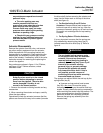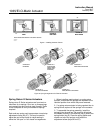
1035/El-O-Matic Actuator
Instruction Manual
Form 5417
February 2007
11
Figure 5 . Code A Assemblies
AB
AB
DOUBLE ACTING SPRING RETURN
A7047 / IL
Troubleshooting
If the actuator does not function, make the following
checks:
1. Check for worn teeth on piston racks, if the
actuator exhibits excessive amounts of backlash. If
worn, replace piston/gear rack assembly.
2. Check supply pressure to ensure the air supply is
reaching the actuator. Place a gauge in the line at
the inlet of the actuator. Monitor the gauge for
unexpected pressure drops when operating pressure
is applied to the actuator.
3. Check piston seal leakage. For spring return
actuators, piston seal leakage will show at port B
when port A is pressurized. For double acting
actuators, piston seal leakage will show at port B
when port A is pressurized, or vice versa.
4. Check actuator movement. Remove the actuator
from the valve. Apply reduced air pressure [0.7
to 1.0 bar (10 to 15 psi) for double acting, or 1.4
to 2.0 bar (20 to 30 psi) for spring return] to see if the
actuator will cycle under a no-load condition.
D If the actuator cycles under a no-load
condition, please refer to the valve instruction
manual for valve troubleshooting or contact your
Emerson Process Management sales office.
D If the spring set number is 5 or 6, it may not
cycle with the reduced air pressure amounts
listed above and may require retesting with up
to 5.5 bar (80 psi) to stroke a full 90 degrees.
D If the actuator does not
cycle, disassemble
the actuator using the Actuator Disassembly
procedures. Inspect and replace parts as
necessary.
If the actuator and valve are moving freely,
reassemble the valve/actuator assembly and re-test.
If unit still fails to operate, consult your Emerson
Process Management sales office for assistance.
Maintenance
Actuators parts are subject to normal wear and must
be inspected and replaced as necessary. The
frequency of inspection and replacement depends
upon the severity of service conditions. Instructions
are given in subsequent sections for disassembly
and assembly of the actuator and for inspecting the
actuator parts.
WARNING
Avoid personal injury from sudden
release of process pressure. Before
performing any maintenance
operations:
D Disconnect any operating lines
providing air pressure, or a control
signal to the actuator. Be sure the
actuator cannot suddenly open or
close the valve during maintenance.
D Use bypass valves or completely
shut off the process pressure. Relieve
process pressure on both sides of the
valve. Drain the process media from
both sides of the valve.
D Vent the power actuator loading
pressure and relieve any actuator
spring precompression.
D Use lock-out procedures to be
sure that the above measures stay in
effect while you are work on the
equipment.
D Always wear protective gloves,
clothing and eyewear when performing


















